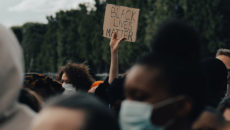The African-American population in the U.S. has a higher incidence of many common health complications. For instance, the incidence of diabetes is about 70 percent higher than for the Caucasian population. High blood pressure is also more common, with a higher risk of resultant stroke and heart attack. Much of this disparity can be traced to inequality of access to health care.
The significantly higher rates of sickle cell anemia within the African-American community, however, are based on a specific genetic risk. One out of 12 African Americans carries the sickle cell gene, referred to as “sickle cell trait,” but does not have symptoms of the disease. When two sickle cell carriers conceive, there is a 25 percent chance that the child will have sickle cell anemia, so its important for those with sickle cell trait to receive genetic counseling as they reach adulthood.
About Sickle Cell Anemia
Normal red blood cells are donut-shaped, allowing them to pass through even the smallest blood vessels without difficulty and to carry the optimal amount of oxygen to every part of the body. Sickle cell anemia is so named because red blood cells are shaped like a sickle. Its harder for these irregularly shaped cells to move through the bloodstream, resulting in a decrease in the oxygen distributed through the body.
Screening and Incidence
Although sickle cell anemia is most common in African Americans, children of Latino ethnicity, as well as those of Arabic, Italian, and Asian-Indian ancestry, are also at higher risk. The incidence for the disease is estimated to be one in 500 in the African-American population, and one in 1,000 to 1,400 in the Latino population.
Currently, all children born in the U.S. are tested for sickle cell anemia and sickle cell trait as part of state-mandated newborn screening, and the hospital forwards test results to the child’s pediatrician. If you did not receive records, your child’s doctor should be able to access the information from the state department of health. If you do not know where your child was born, you should request additional screening. Any child born outside the U.S., particularly children born in Africa, should be screened for the sickle cell trait.
Disease Complications and Treatment
In addition to anemia (resulting in chronic fatigue), patients with sickle cell disease (not trait) may have other complications. One of the most common is an increased risk of infection, particularly from bacteria that cause pneumonia. Vaccines for pneumococcus and haemophilus influenza B, given as early as two months of age, may reduce this risk. Children younger than six are often treated daily with penicillin to prevent serious pneumococcal infection.
Blood vessel blockage may cause swelling of the hands and feet in infants. Restricted blood flow through major organs or body parts (including in the chest, belly, joints, and bones) can cause episodes of severe pain, known as painful crisis. The pain is generally managed with medications and, sometimes, IV fluids. As the blood cells break down in the body, children may have jaundice, gallstones, and blood in the urine.
Long-term, a decrease in red blood cell flow and production may result in slower growth rates, frequently leading to a delay in the onset of puberty. Individuals are often treated with daily folic acid, which helps the body to make new red blood cells.
If you have a child diagnosed with sickle cell anemia, he’ll have the best long-term outcome if treated and monitored at a regional sickle cell center. Health care providers at these centers are familiar with the latest research and will optimize treatment. With good health care, children and adults with sickle cell anemia can generally lead healthy, comfortable, productive lives.



